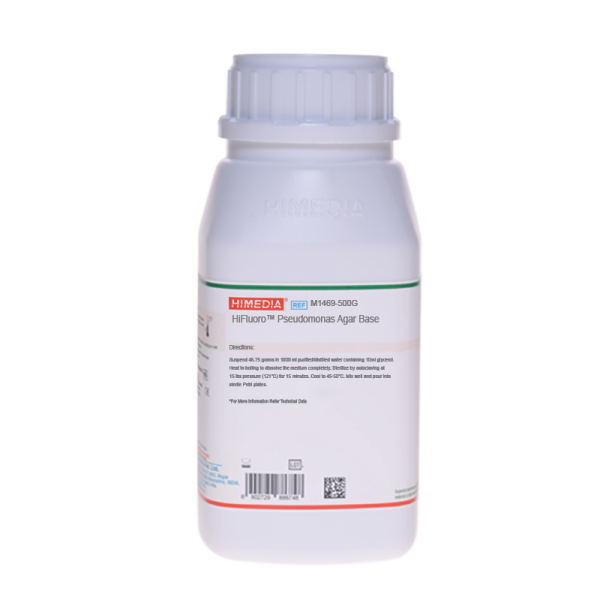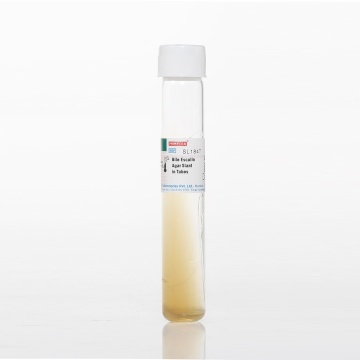 Your enquiry has been submitted
Your enquiry has been submitted
HiFluoro™ Pseudomonas Agar Base
Pseudomonas species#CC293D
Intended Use
Recommended for selective isolation of Pseudomonas aeruginosa from various samples by fluorogenic method.
Composition**
| Ingredients | g / L |
|---|---|
| Gelatin peptone | 18.000 |
| Magnesium chloride | 1.400 |
| Potassium sulphate | 10.000 |
| Cetrimide | 0.300 |
| Fluorogenic mixture | 2.050 |
| Agar | 15.000 |
Final pH ( at 25°C): 7.2±0.2
**Formula adjusted, standardized to suit performance parameters
Directions
Suspend 46.75 gram in 1000 ml purified/distilled water containing 10ml glycerol. Heat to boiling to dissolve the medium completely. Sterilize by autoclaving at 15 lbs pressure (121°C) for 15 minutes. Cool to 45-50°C. Mix well and pour into sterile Petri plates.
Principle And Interpretation
Pseudomonas aeruginosa (also known as Pseudomonas pyocyanea) is a gram-negative, aerobic, rod-shaped bacterium. Like other Pseudomonas, P. aeruginosa secretes a variety of pigments, including pyocyanin (blue-green), fluorescein (yellow - green and fluorescent), and pyorubin (red-brown). King et al developed Pseudomonas Agar P (i.e. King A media) for enhancing pyocyanin and pyorubin production and Pseudomonas Agar F (i.e. King B media) for enhancing fluorescein production (1). HiFluoro™ Pseudomonas Agar Base is devised based on the formula described by King et al. (2) except fluorogenic mixture. It can be used as the selective medium for the isolation of P. aeruginosa from pus, sputum and drains etc. Cetrimide (Cetyltrimethylammonium bromide) is incorporated in the medium to inhibit bacteria other than P. aeruginosa. It acts as a quaternary ammonium compound, cationic detergent that causes nitrogen and phosphorus to be released from bacterial cells other than P.aeruginosa. P.aeruginosa cleaves the fluorogenic compound to release the fluorogen which produces a visible fluorescence under long wave UV light.
Type of specimen
Water samples.
Specimen Collection and Handling
For water samples, follow appropriate techniques for sample collection, processing as per guidelines & local standards (1). After use, contaminated materials must be sterilized by autoclaving before discarding.
Warning and Precautions
Read the label before opening the container. Wear protective gloves/protective clothing/eye protection/ face protection. Follow good microbiological lab practices while handling specimens and culture. Standard precautions as per established guidelines should be followed while handling specimens. Safety guidelines may be referred in individual safety data sheets.
Limitations
- Due to variable nutritional requirements, some strains show poor growth on this medium.
- Further biochemical and serological test needs to be carried out for confirmation.
Performance and Evaluation
Performance of the medium is expected when used as per the direction on the label within the expiry period when stored at recommended temperature.
Quality Control
Appearance: Cream to yellow homogeneous free flowing powder
Gelling: Firm, comparable with 1.5% Agar gel
Colour and Clarity of prepared medium: Light amber coloured, opalescent gel with slight precipitate forms in Petri plates
Reaction: Reaction of 4.67 % w/v aqueous solution at 25°C. pH : 7.2±0.2
pH: 7.00-7.40
Cultural Response
Cultural characteristics observed after an incubation at 35-37°C for 24- 48 hours.
| Organism | Inoculum (CFU) | Growth | Recovery | Fluorescence (under uv) |
|---|---|---|---|---|
| Pseudomonas aeruginosa ATCC 27853 (00025*) | 50-100 | good-luxuriant | >=50% | positive |
| Stenotrophomonas maltophila ATCC 13637 | >=10⁴ | inhibited | 0% | |
| Staphylococcus aureus subsp. aureus ATCC 25923 (00034*) | >=10⁴ | inhibited | 0% | |
| Escherichia coli ATCC 25922 (00013*) | >=10⁴ | inhibited | 0% |
Key: (*) Corresponding WDCM numbers
Storage and Shelf Life
Store between 15-25°C in a tightly closed container and the prepared medium at 2-8°C. Use before expiry date on the label. On opening, product should be properly stored dry, after tightly capping the bottle in order to prevent lump formation due to the hygroscopic nature of the product. Improper storage of the product may lead to lump formation. Store in dry ventilated area protected from extremes of temperature and sources of ignition. Seal the container tightly after use. Product performance is best if used within stated expiry period.
Disposal
User must ensure safe disposal by autoclaving and/or incineration of used or unusable preparations of this product. Follow established laboratory procedures in disposing of infectious materials and material that comes into contact with sample must be decontaminated and disposed of in accordance with current laboratory techniques (3,4).
Reference
- Lipps WC, Braun-Howland EB, Baxter TE,eds. Standard methods for the Examination of Water and Wastewater, 24th ed. Washington DC:APHA Press; 2023.
- King, Ward and Raney, 1954, J. Lab. Clin. Med., 44:301.
- Isenberg, H.D. Clinical Microbiology Procedures Handbook 2nd Edition.
- Jorgensen, J.H., Pfaller, M.A., Carroll, K.C., Funke, G., Landry, M.L., Richter, S.S and Warnock., D.W. (2015) Manual of Clinical Microbiology, 11th Edition. Vol. 1.
| Product Name | HiFluoro™ Pseudomonas Agar Base |
|---|---|
| SKU | M1469 |
| Product Type | Regular |
| Physical Form | Powder |
| Origin | Animal |
| Packaging type | HDPE |
| References | 1.King, Ward and Raney, 1954, J. Lab. Clin. Med., 44:301. |
| Customized Product Available | No |








